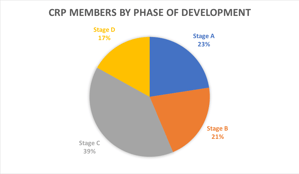 As a national network, Cities Reducing Poverty (CRP) now supports more than 70 cities and communities, representing over 250 municipalities, to reduce poverty locally.
As a national network, Cities Reducing Poverty (CRP) now supports more than 70 cities and communities, representing over 250 municipalities, to reduce poverty locally.
The CRP team convenes online peer discussions, hosts webinars, co-authors stories with members, and leads workshops; while their experiences are being captured, the CRP team listens to members and learns from their stories.
This convening and learning has surfaced four broad phases that successful poverty reduction collaboratives go through. They are:
- Early development
- Establishing a community-wide common agenda
- Implementing the plan
- Sustainability
Early Development
The earliest phase of development in a successful poverty reduction initiative starts with some interest in the community to tackle poverty in a different way, and the energy of just a few people - holding key positions - who are willing to commit the time and resources to bring the community together and build the momentum to create a common vision.
Establishing a Community-Wide Common Agenda
The second significant phase of development is establishing a community-wide common agenda. During this phase, the momentum to act on poverty moves beyond the initial group or roundtable and engages the entire community – including all four sectors – in establishing a common goal and complementary ways of working.
Implementing the Plan
The third phase is moving from planning to implementation. At this stage, the work shifts from planning to action, people take on new roles with the collaborative, and organizations work differently to achieve the community priorities.
Sustainability
The final stage of a successful poverty reduction effort is ensuring the initiative is sustainable enough to meet its long-term goals and is contributing to sustainable change. This requires continuing momentum; financial and leadership commitments; continually learning, improving and scaling efforts; and working towards policy and systems change.
 While there is a greater percentage of CRP network members that have poverty reduction strategies and are in the early stages of implementing them, of the 70+ members that Cities Reducing Poverty supports, 44% of members do not have plans yet. Members join the network at all different phases of development and are supported to progress from wherever they are, to the next phase(s). The breakdown is depicted in Table 1.
While there is a greater percentage of CRP network members that have poverty reduction strategies and are in the early stages of implementing them, of the 70+ members that Cities Reducing Poverty supports, 44% of members do not have plans yet. Members join the network at all different phases of development and are supported to progress from wherever they are, to the next phase(s). The breakdown is depicted in Table 1.
Due to the range of experience and capacity in the network, members come with a variety of challenges to discuss with peers and experts, which range from just beginning local conversations about poverty reduction actions, to how to influence regional-wide policy and systems changes.
The case study Four Phases of Poverty Reduction in Saint John provides an overview for members in Stages A and B – or those considering/renewing their initiative – of what all four phases are, and an example of what each of those phases has looked like on the ground for a community that is successfully reducing poverty.
Living SJ, the collective impact poverty reduction initiative in Saint John, started with just one influential champion changing the conversation. The group is now reporting real changes for families living in inner city neighbourhoods, including closing the education-achievement gap for children living in those communities, thanks to investments from cradle to career.
Learn about how Saint John got started, adopted collective impact, created a truly community-wide strategy, and scaled to the level of influencing provincial policy changes. Explore the leverage points – key people, relationships and moments - in their system that helped them scale their efforts, as well as their lessons at each stage along the way.
Learn More:
- Read the Living SJ case study.
- Read Living SJ’s Social Renewal Strategy
- Download the 2016 strategy infographic
- Read the 2018 report to the community





